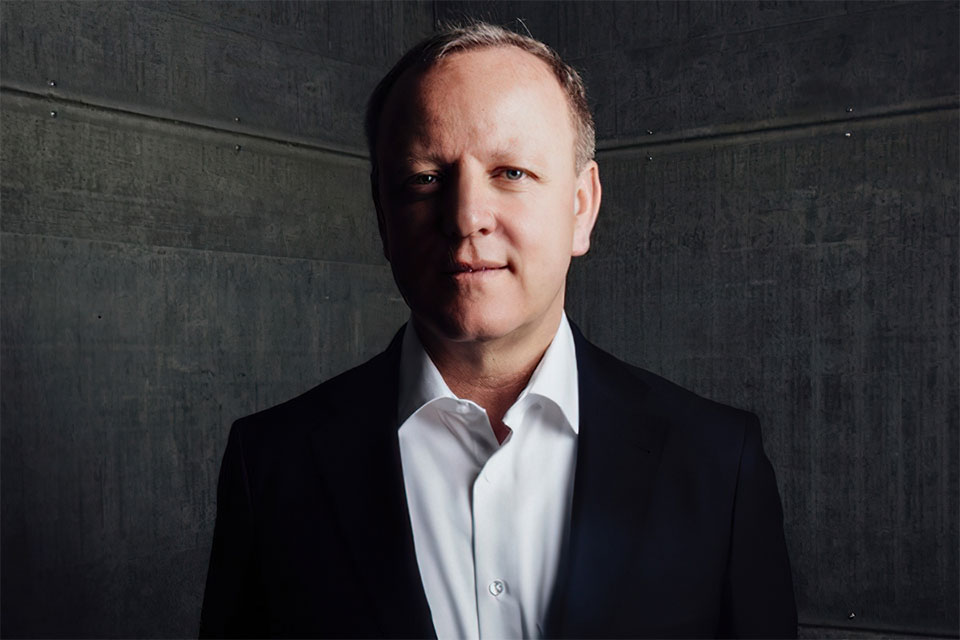Stefan Krause Discusses Modern Rethinking of Current On-Demand Mobility

- With design and technology changing rapidly, the entire thought process is being reevaluated by up-and-coming entrepreneurs.
- The doers and dreamers are looking for gaps in the current markets where improvements can be made for more efficient and effective design.
Stefan Krause is one of those industry disruptors who has set out to change the way we think about cars. He is the CIO and CFO of Levere Holdings Acquisition Corp and the founder of EVelozcity. He has served as chairman at Rolls Royce. He was the youngest ever CFO at BMW, where strong perpetual growth was expected. He then joined Deutsche Bank as CFO, where he faced serious loss and over-leveraged capital, risk managing a derivatives book of $54 trillion dollars. Most recently, Krause accepted a board position at Velo3D, a manufacturing solution company. Krause will serve as the company’s audit committee chair.
On the “Danny in the Valley Podcast,” Stefan Krause joins to discuss a number of topics with host Danny Fortson. One thing on which he really focuses is his vision for how he could reshape the car industry with a completely new approach to design.
How Do Expectations for Design Hold Us Back?
Stefan Krause says that people have a predetermined idea about how something should look or work. People get so wrapped up in that way of thinking that it can become a rut that keeps everyone trapped. After a hundred years on the combustion engine and cars looking a certain way, many designers aren’t breaking that mold.
“People have a pretty determined view of what a car needs to look like,” says Stefan Krause. “And obviously, over the next couple of years, that will change.”
Instead of going with the classic design, Krause is creating an electric car that is similar to a flat skateboard of batteries. This gives him freedom to rethink special configurations. He says that his cars could have the footprint of a VW Golf with the space of a suburban.
All of this is possible if the typical combustion engine is removed. Now, the handful of parts can be moved to the base skateboard design, and any kind of car can then be built on top.
It’s been difficult for people to rethink the design of the car completely. We are very used to the familiar shapes. Those design expectations often slow down the progress because people aren’t comfortable with too many changes too quickly.
Solving Transportation Problems
One serious concern in our growing world boils down to effective transportation solutions. Cars create pollution and waste, which Krause believes that he can change. He explains how his designs could make a huge difference regarding some of the concerns facing traditional vehicles.
Safety Solutions
With the skateboard chassis design and the engine removed from the front, there are fewer parts to worry about pushing into the cabin. Krause says that cars can be safer without this design flaw.
“You have to still consider… the safety of our drivers and passengers,” Krause explains. “So you have to build a crumple zone. But this crumple zone also now doesn’t have to deal with a heavy engine in a frontal crash situation that has to move out and not intrude into the passenger cabin. So you can build a very different crumple zone that can be even much safer than in a combustion engine car because you don’t have all this heavy stuff going into the crash zone.”
Smaller Footprint
“You’re pretty free to use this space in a much better way,” says Krause. “So you can have a car that has a much smaller footprint overall and has an extremely big space inside.” He says that, while the combustion engine has a few thousand pieces, the electric car has closer to 10.
Better Experience
The car should be designed for the riders, according to Krause. But he notes that many cars have extremely small backseats and are too cramped in their design. With the skateboard chassis, each car will have it’s own “top hat,” as Krause calls them. From individuals to brands, vehicles can be made in ways that enhance the consumer experience like never before.
Living/Working Space
Krause isn’t just looking at cars for transportation. He sees people working and even living in their cars – and this is made even easier with cars of the future. “You know, don’t forget the VW bus from ’65,” he says. “I have one, and love it so much.”
With cars redesigned, the interior space can be used for meetings and work as people commute. He says that even taxis or rideshare vehicles can offer a much more convenient space to their fares.
Advertising Space
With some custom top hats, the new electric cars would be able to feature illustrations, branding, and colors that help a company advertise on the road. Krause says that this is very important as many consumers shift away from in-person brick-and-mortar stores and toward online shopping.
“As companies and retail stores lose their ability to present their corporate identity or use the layout of the store to tell people who they are and what they represent, our view is that, in the future, they may use a vehicle,” Krause says. “They may not want to just have a branded vehicle with a sticker of the company logo on it because that’s not differentiating. But maybe down the road, with this ability to build a completely customized cabin on top of the skateboard, any company could decide to have their own delivery vehicle so the customer doesn’t see a UPS or a FedEx truck. The companies can express themselves in the city. People see them and they work as advertising.”
The Importance of Small Changes Over Time
One of the hard things, Krause says, has been the speed of change. Things are already changing fast, and people don’t handle too much change well.
Tesla had to defy many naysayers when it shifted its focus to electric models. Krause says that the company didn’t really have the luxury of doing a major design overhaul because it was just paving the way for electric technology; the car still needed to look like a car.
But EVelozcity doesn’t have that same hurdle in front of it. The company can focus its time and energy on improving the expenses and reconfiguring the design of the vehicle.
In 2020, more than 760,000 EVs (electric vehicles) were sold for a fifth consecutive year of growth. This record in EV industry growth is expected to be passed in 2021.
Optimizing the Process
“We do believe that electric drive trains will be more expensive for a long, long time,” admits Krause. “We invested over 100 years in optimizing the combustion engine. And I think it’s just going to take time before we get to cost and performance parity. So, that’s why we didn’t base our business model on that assumption.”
But, ultimately, Krause believes that they can deliver on a product that doesn’t have the same intense need for car repairs that so many car owners hate with a passion. His goal is to simplify the build so that the cost isn’t in a million little details.
“Let’s take the cost out of the rest of the business model,” says Krause. “Let’s live with higher product costs. Therefore, let’s also live with reduced margins because we cannot pass on all these costs to consumers over time. To be competitive now, let’s look at the rest of the process. Let’s work with fewer suppliers [and] use suppliers that provide more overall car parts. Let’s think about how we change manufacturing.”
Right now, EVelozcity has a price point goal of $35k. But Krause says that the company is considering lease and ride-sharing programs as well. Nothing is off the table.
More Convenience With Less Responsibility
One way of rethinking the car industry is the realization that not everyone needs to own a car. Krause points to the success of rideshare apps (like Lyft and Uber), as well as how many car manufacturers have lease programs. Krause said that when he worked with BMW, leadership within the company received new cars that were swapped out every six months or so. He says that most people don’t want to worry about repairs and breakdowns.
With cars of the future, Krause believes that there should be more systems in place from the start to encourage sharing vehicles – especially in big cities.
“I think that’s going to be a big change that we also will see in terms of how people are thinking about car ownership and car utilization and models like this,” he says. “If you look at vehicles parked in the city, 90 percent of them are parked. There’s so much capital bound in metal sitting there, rusting away. And it’s only because, with today’s mindset, it’s the only way I can ensure on-demand mobility. I own a car. So if you think that… through, what people really want (and why they spend so much money) is to have on-demand (every time, every minute) mobility.”
People don’t want to wait for rides or wonder if they will have access. Krause says that future innovators need to consider this reality when creating strategies. “And, of course, there are ways to provide it with modern technology,” he continues. “We believe that these models are going to evolve. Why do you need to have $50,000 sitting in an asset only because you want to afford yourself on-demand mobility?”
Krause believes that there are other ways, and people will quickly be willing to give up ownership of cars if there are other workable (and cheaper) solutions.
Less Waste Through Technology and Changed Thinking
Krause says that he expects solutions to adapt to meet people’s needs with less waste involved. Rather than push for a new electric car in every household, Krause wants to encourage social sharing and conscious purchasing.
“I think the model is going to become: you don’t want to have the hassle [of having] to go and ensure your car and register and pay the taxes,” he says. “So, we can provide it all, and you just pay a monthly utilization fee. And, maybe, if over the weekend, you need a bigger car because you’re going out with more friends or things like that, then you can switch, which, as an employee of BMW, is what I could do. Why not?”
Ultimately, Krause hopes that people will continue to improve their personal habits in ways that will reduce harm to the environment. “What will address the problem of the daily congestion and the risk and the dirt and the environmental issues?” he asks. His answer: EVelozcity.
For now, he has his sights set on establishing these versatile cars in megacities with populations of more than 10 million. Not only do they have more access to charging stations and less need for personal transportation, but they also have less space for parking and more issues with pollution. If he can get things changed in those cities, then he may branch out to other areas. But his plans are to stick with the megacities that need his product.
“We don’t have any ambitious plans in the sense of volume,” Krause says.
The EVelozcity cars are aiming for a range of about 250 miles before they need to stop and charge. “We think by the time we come out, charging networks are well developed. So I don’t think the main driver is range. And we think, with 250 miles, you have plenty for a week of commuting and what you normally need.”
Krause encourages all entrepreneurs to think beyond the scope of normal. He believes that the space for ideas is bigger now than ever before, but so is the temptation to stay in the rut of expectation. Industry disruptors are always ready to challenge the status quo.
Add CEOWORLD magazine to your Google News feed.
Follow CEOWORLD magazine headlines on: Google News, LinkedIn, Twitter, and Facebook.
Copyright 2024 The CEOWORLD magazine. All rights reserved. This material (and any extract from it) must not be copied, redistributed or placed on any website, without CEOWORLD magazine' prior written consent. For media queries, please contact: info@ceoworld.biz








